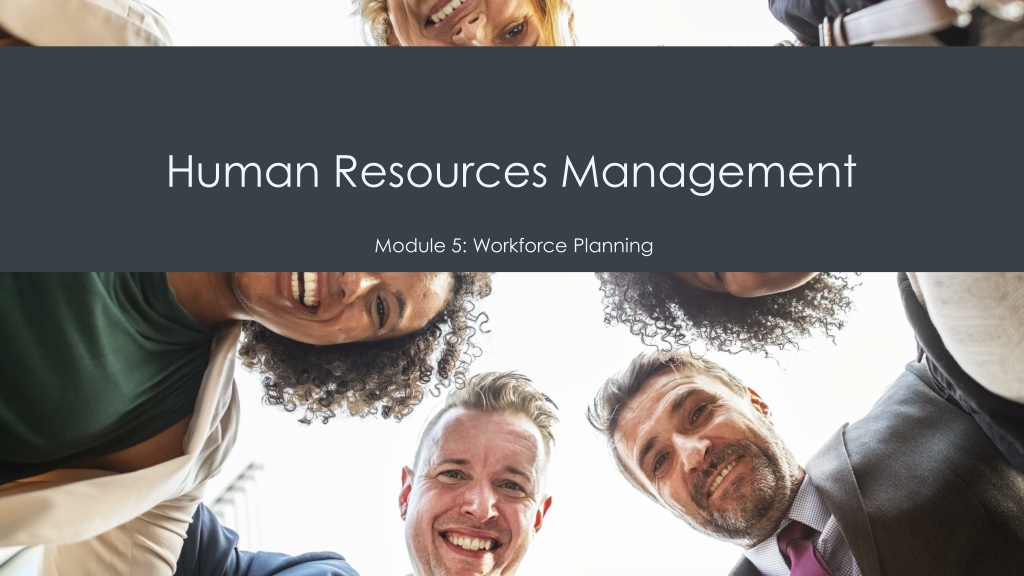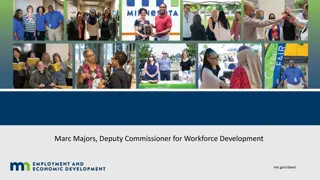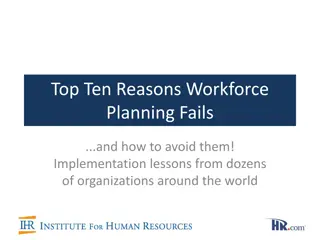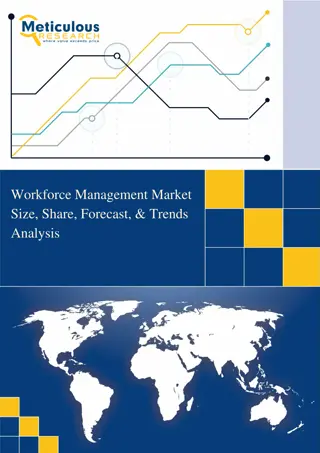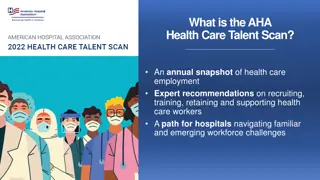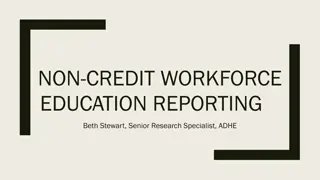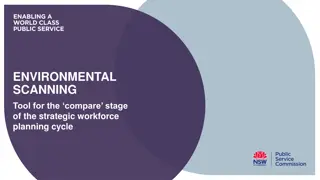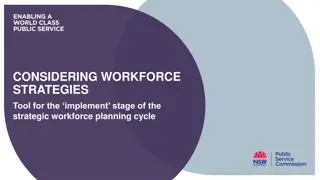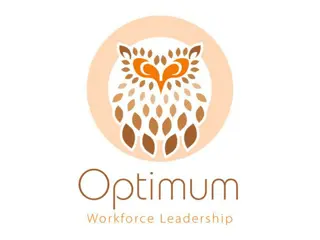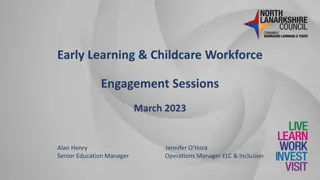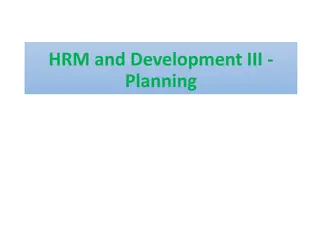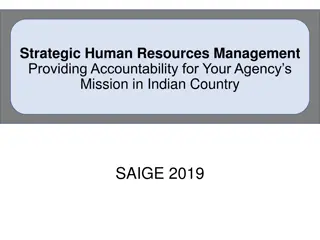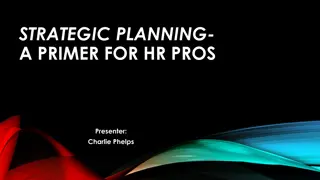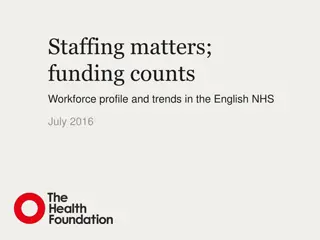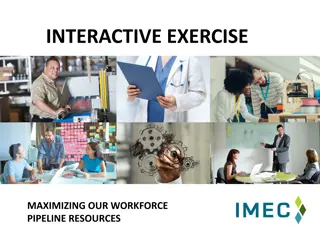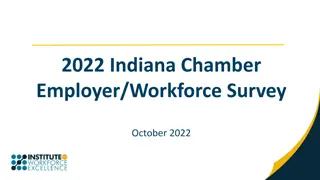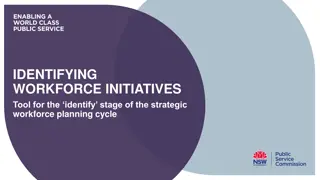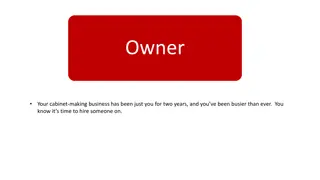Strategic Workforce Planning and Analysis in Human Resources Management
Understand the essential elements of workforce planning, job analysis, and job design to align with business strategies. Learn about current workforce assessment, future requirements, and gap analysis to bridge resource needs. Explore the continuous process of workforce planning to ensure the organization's talent meets strategic objectives through systemic analysis and action planning.
Download Presentation

Please find below an Image/Link to download the presentation.
The content on the website is provided AS IS for your information and personal use only. It may not be sold, licensed, or shared on other websites without obtaining consent from the author. Download presentation by click this link. If you encounter any issues during the download, it is possible that the publisher has removed the file from their server.
E N D
Presentation Transcript
Human Resources Management Module 5: Workforce Planning
Module Learning Outcomes Describe the processes of job analysis, job design, and employment forecasting and discuss their importance in workforce planning 5.1: Describe the steps in the workforce planning process 5.2: Describe the job analysis process 5.3: Explain the purpose and elements of job descriptions 5.4: Discuss job design techniques and impacts
Learning Outcomes: Workforce Planning Process 5.1: Describe the steps in the workforce planning process 5.1.1: Describe the relationship between business strategy and workforce planning 5.1.2: Describe how to assess current human resources 5.1.3: Discuss how to determine the demand for and supply of labor 5.1.4: Discuss the outcome of workforce planning
Business Strategy and Workforce Planning The role of human resource management is to ensure that an organization has the talent to achieve strategic goals Workforce planning is a complex research and design problem involving a detailed understanding of a role Workforce planning is generally done on a multi-year horizon Workforce planning is continuous rather than linear
The Workplace Planning Process Strategic Planning: align workforce planning process with strategic plan Current Workforce Analysis: analyze current resources Future Workforce Requirements: Develop specifications to accomplish strategic objectives Gap Analysis: Identify gaps between current and projected workforce needs Action Planning: Identify how to close resource gaps with a range of activities Execution and Evaluation: Execution through establishing roles, responsibilities, and resources and evaluation through monitoring progress relative to goals and making adjustments
Why Assess Your Current Human Resources? Assessing current human resources involves developing a profile of the workforce Purpose of work: provides the data for the workforce plan using systemic analysis Deliverables: a comprehensive analysis of the department s staffing and competency gaps Primary Steps: develop the profile of your current workforce including staffing and competencies, use the results from strategic planning to project future HR needs, perform a gap analysis, and develop and prioritize a list of HR risks
Assessing Current Human Resources Personnel assessment include a systematic approach to gathering information about individuals used to make employment or career- related decisions A properly designed assessment is important to reduce bias and uphold equity and job relevance An irrelevant assessment undermines the assessment and broader planning process
Assessing Current Human Resources, continued Reliability is the extent to which an assessment tool is consistent or free from random error in measurement Validity is the extent to which an assessment tool measures what it intended to measure To develop valid assessments: Identify job-relevant competencies Design the assessment strategy Identify assessment tools Use assessment tools properly, with awareness of both the benefits and limitations of any strategy
Labor Supply and Demand The organization s demand for labor is based on a range of both macro- and micro-level factors At both the industry and individual business level, the consumer controls labor Current employees should be evaluated based on their ability to meet projected future requirements, factoring in training, reskilling, lateral transfers and promotions Businesses tend to use one or a combination of qualitative and quantitative approaches to analyze internal labor supplies Human resource management may develop replacement charts to track high potential talent and succession planning needs The Markov analysis can be used to track the pattern of employee movements within the organization and develop a transitional probability matrix for forecasting internal supply by specific categories
Labor Supply and Demand, continued Analytics is likely to be an integral part of the workforce planning process One of the key opportunities in using analytics in workforce planning is to spot talent trends and gaps Performance management data can identify underutilized resources, upskilling opportunities, and leadership training needs The external supply of labor is a function of a range of economic and qualitative factors including availability of housing, transportation, quality of life, and quality educational and training options Wages, competition for labor, demographic and immigration trends, and policies and individual preferences of utility as well as job structure also impact the availability of labor and labor force participation
Workforce Planning Outcomes The outcome of the workforce planning process is a workforce development plan that translates human resource-related analysis conducted strategic planning processes into an action plan Diablo Valley College s Workforce Development Plan Case Example: Vision Statement. A projection of what the future would look like if Workforce Development Programs were completely successful Mission Statement. How DVC workforce development proposes to reach the envisioned future Guiding Principles. Criteria for making decisions about strategies that support the goals Goals. What the plan is intended to work toward in the next five years Implementation Grid. Long-term outcomes, strategies that will lead to these outcomes, and anticipated intermediate outcomes for each strategy.
Practice Question 1 Which of the following is the first of the primary steps for compiling and analyzing human resource data? A. Use the results from the strategic planning phase to project human resource needs B. Perform a gap analysis to identify current and future staff and competency needs C. Develop a profile of your current workforce to include both staffing and competencies D. Develop and prioritize a list of human resource risks to inform the workforce action planning
Learning Outcomes: Job Analysis Process 5.2: Describe the job analysis process 5.2.1: Describe the purpose of job analysis 5.2.2: Identify the steps in the job analysis process 5.2.3: Identify sources of information for job analysis 5.2.4: Describe the job analysis process
Purpose of Job Analysis The purpose of job analysis is to establish what a job entails, including the KSAs as well as job duties and responsibilities and the job conditions Job analysis is a fundamental resource for human resources management Job analysis serves four primary purposes: Establish and document job-related competencies Identify the job-relatedness of essential tasks and competencies Establish the legal basis for assessment and selection procedures/decisions Establish the basis for determining relative worth
What is Job Analysis? Job analysis has job-specific steps for gathering, documenting, and analyzing information about the job Establish the organizational relevance of the specific role: Identify how the job relates to the organization s strategy Benchmark positions, if necessary: If it s impractical to conduct an analysis of every role, jobs can be grouped into categories that have similar characteristics Identify inputs: Determine what data sources will be used and how information will be collected Draft the job description: Formats vary, but there are common and required elements Finalize the job description: Review the draft job description with the job supervisor and make revisions as appropriate
Sources of Information Internal sources of information include published information, input from management, employees and/or a relevant subject matter expert, job incumbent log of daily activities O*Net OnLine database is updated regularly and contains standardized and occupation- specific descriptors on almost 1,000 occupations
O*Net Data O*Net data is organized into the following domains: Worker Characteristics: enduring characteristics may influence performance and capacity to acquire knowledge and skills Worker Requirements: Descriptors referring to work-related attributes Experience Requirements: Requirements related to previous work activities Occupational Requirements: A comprehensive set of variables or detailed elements required by occupations Workforce Characteristics: Variables that define and describe the general characteristics of occupations Occupation-Specific Information: Variables or other Content Model elements of occupations
Completing Job Analysis A job analysis is not an evaluation of the person currently performing the job Collecting Data: Gathering information from published sources, observation, interviews, online databases Developing Tasks: Developing a description of daily activities to perform functions of the job Developing Competencies: Describing the knowledge, skills, abilities, behaviors, and other characteristics required for job performance Validating & Rating Tasks & Competencies: Subject matter expert review and rating of tasks and competencies Finalizing Tasks & Competencies: Finalization of tasks and competencies The OPM recommends that tasks that are rated as both frequent and important to be considered critical for the job
Practice Question 2 Conducting a job analysis includes which of the following processes? A. Hiring new people B. Creating jobs C. Developing competencies D. Evaluating current employees in a position
Learning Outcomes: Job Descriptions 5.3: Explain the purpose and elements of job descriptions 5.3.1: Identify the elements of a job description 5.3.2: Differentiate among job analysis, job descriptions and job specifications
Understanding Job Descriptions A job description is a written statement of what a position entails and should be incumbent neutral Job Title: job title and other reference information Reporting Relationships: Identification of the department the job is part of including the position the role reports to and any supervisory responsibilities Job Summary: A brief overview of the role, including its purpose, level, and scope of responsibility Job Specifications: The minimum acceptable qualifications for the job including education, experience, and specialized knowledge or skills, if applicable A job analysis is an internal document that serves as the basis for both job descriptions and job specifications A key distinction is that the details listed under job description are not personal while job specifications reflect what s required to complete the job and are personalized to each employee
Job Analysis vs. Job Descriptions vs. Job Specifications A job analysis is an internal document that serves as the basis for both job descriptions and job specifications. Table 1. Job Analysis produces a Job Description and Job Specifications Job Description Job Specifications Job Title Qualifications Job Location Experience Job Summary/Duties/Responsibilities Training Reporting to Skills Working conditions/Hazards Emotional Characteristics
Learning Outcomes: Job Design 5.4: Discuss job design techniques and impacts 5.4.1: Discuss the concept of job design 5.4.2: Discuss job design theories and characteristics
What is Job Design? Job design is a work arrangement aimed at reducing or overcoming job dissatisfaction and employee alienation arising from repetitive and mechanistic tasks Factors of job design include what tasks are done, how they are done, how many tasks are done, and in what order the tasks are done The primary purpose of job design is to increase employee motivation, productivity, and satisfaction In addition to motivation factors, job design for safety takes into account factors such as task/machine pacing and work breaks to reduce risk
Job Design Theories Job Relevance: To avoid turnover and engagement issues, job significance and relevance should be designed at every level and length of tenure Job Enlargement: Expands the number of tasks one person is responsible for and needs to be coupled with training to develop competency in performing the additional tasks and can increase job satisfaction Job Enrichment: Job enrichment is the addition of different tasks associated with a job that provides greater involvement and interaction with that job and should use the full ability of the employee and provide sufficient challenge
The Job Characteristics Theory Organizational psychologists J. Richard Hackman and Greg Oldham built on Herzberg, developing a job design model based on the following job characteristics: Skill Variety: degree to which a job requires a variety of different activities in carrying out the work Task Identity: degree to which the job requires completion of a whole, identifiable piece of work Task Significance: degree to which the job has a substantial impact on the lives of other people Autonomy: degree to which the job provides substantial freedom, independence, and discretion to the individual Feedback: degree to which carrying out the work activities required by the job provides the individual with direct and clear information
Class Activity: Job Design In thinking about the purpose of job design to increase employee motivation, productivity, and satisfaction, pick either your current or a previous job title you have held. Pick one technique of job design (job relevance, job enlargement, job enrichment). How would you design your job in the chosen job design technique? What are the important steps to identify important tasks? What are the job tasks included and how do you connect their purpose to the company mission? How does your job design support employee satisfaction and motivation? Discuss challenges you experienced designing a job you hold or have held.
Quick Review What are the qualities of the relationship between business strategy and workforce planning? How is assessment done in current human resources? How do you determine the demand for and supply of labor? What is included in the outcome of workforce planning? What is the purpose of job analysis? What are the steps in the job analysis process? What are the sources of information for job analysis? What is included in the job analysis process? What are the elements of a job description? How are job analysis, job descriptions and job specifications differentiated? What is included in the concept of job design? What are the job design theories and their characteristics?
